Child Healthcare and Medication Safety: A Literature Review
VerifiedAdded on 2020/12/10
|12
|3452
|222
Literature Review
AI Summary
This literature review examines medication safety within the context of Australian child healthcare and protection. It explores several key themes, including an analysis of the Australian child protection system, complex issues impacting child and family nursing practices, and the increasing risks associated with childhood obesity. The review highlights the role of government policies, healthcare practices, and societal factors in influencing child health outcomes. It also discusses the importance of medication safety measures, such as the Paediatric National Inpatient Medication Chart (PAED-NIMC), and the need for proper communication and record-keeping to minimize medication errors. The review further investigates the prevalence of childhood obesity, its contributing factors (including diet, lack of physical activity, and socio-economic inequalities), and potential interventions for prevention. The review also includes the analysis of medication safety system in Australia. The review concludes with recommendations for addressing these critical issues and improving the health and well-being of children in Australia.
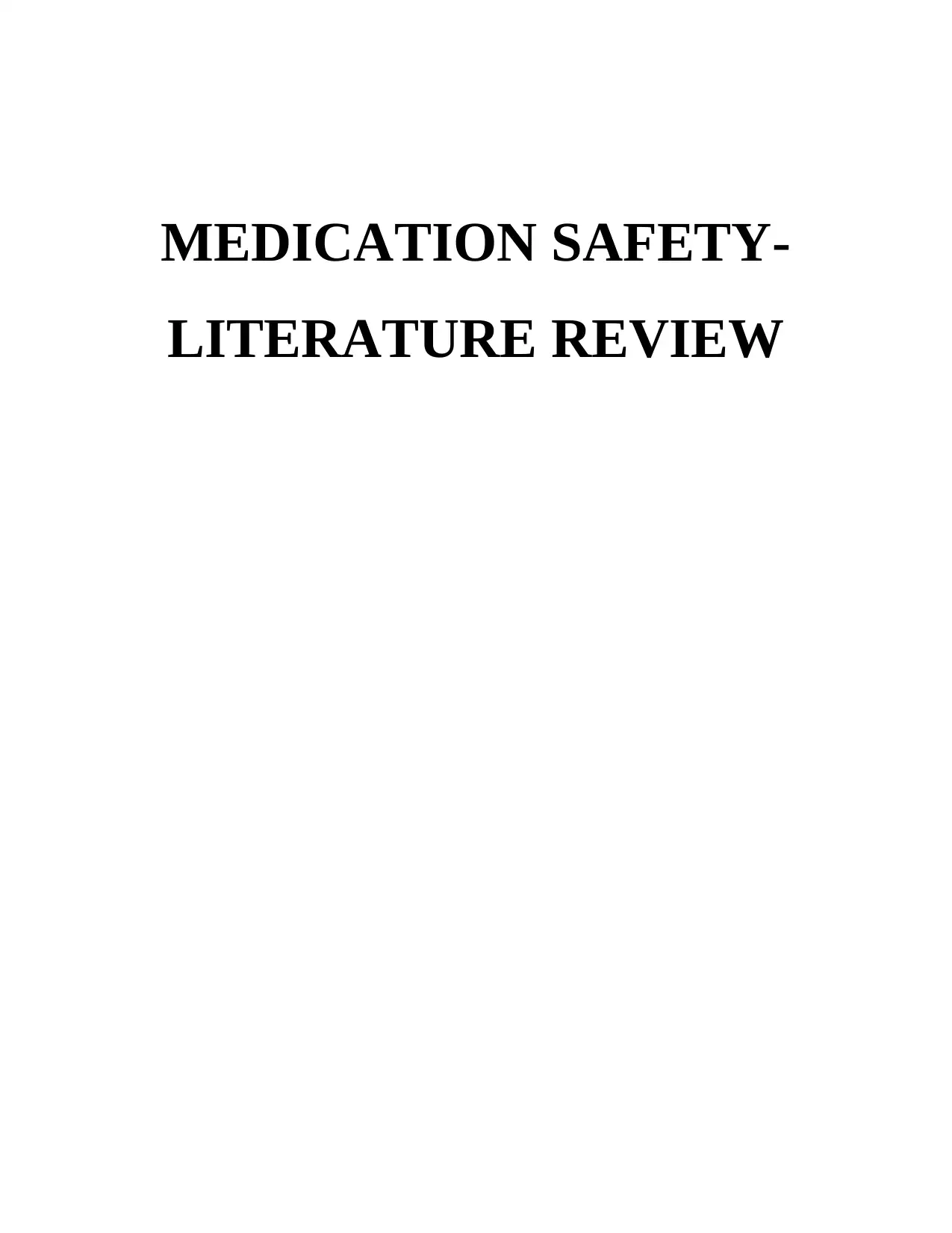
MEDICATION SAFETY-
LITERATURE REVIEW
LITERATURE REVIEW
Paraphrase This Document
Need a fresh take? Get an instant paraphrase of this document with our AI Paraphraser
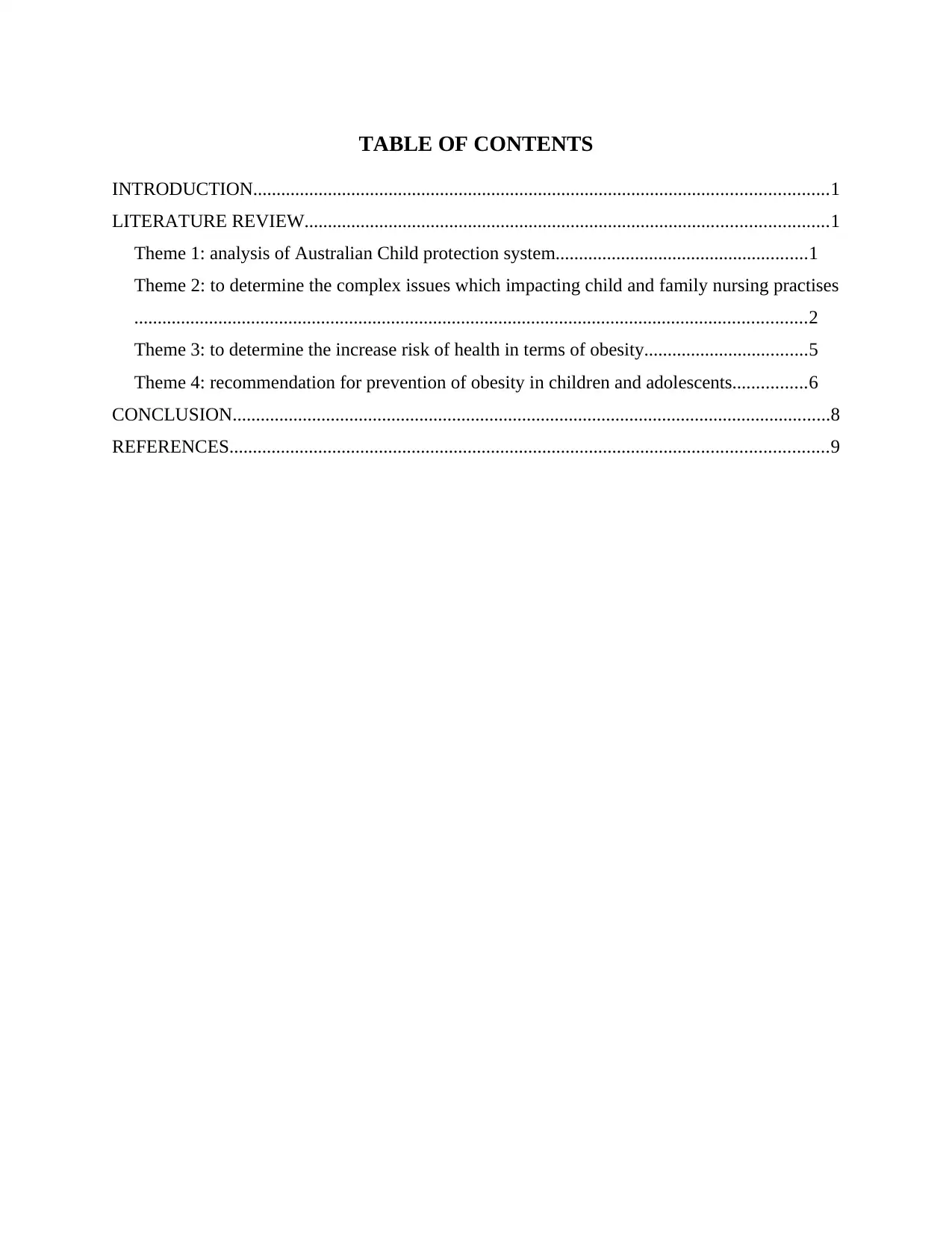
TABLE OF CONTENTS
INTRODUCTION...........................................................................................................................1
LITERATURE REVIEW................................................................................................................1
Theme 1: analysis of Australian Child protection system......................................................1
Theme 2: to determine the complex issues which impacting child and family nursing practises
................................................................................................................................................2
Theme 3: to determine the increase risk of health in terms of obesity...................................5
Theme 4: recommendation for prevention of obesity in children and adolescents................6
CONCLUSION................................................................................................................................8
REFERENCES................................................................................................................................9
INTRODUCTION...........................................................................................................................1
LITERATURE REVIEW................................................................................................................1
Theme 1: analysis of Australian Child protection system......................................................1
Theme 2: to determine the complex issues which impacting child and family nursing practises
................................................................................................................................................2
Theme 3: to determine the increase risk of health in terms of obesity...................................5
Theme 4: recommendation for prevention of obesity in children and adolescents................6
CONCLUSION................................................................................................................................8
REFERENCES................................................................................................................................9

⊘ This is a preview!⊘
Do you want full access?
Subscribe today to unlock all pages.

Trusted by 1+ million students worldwide
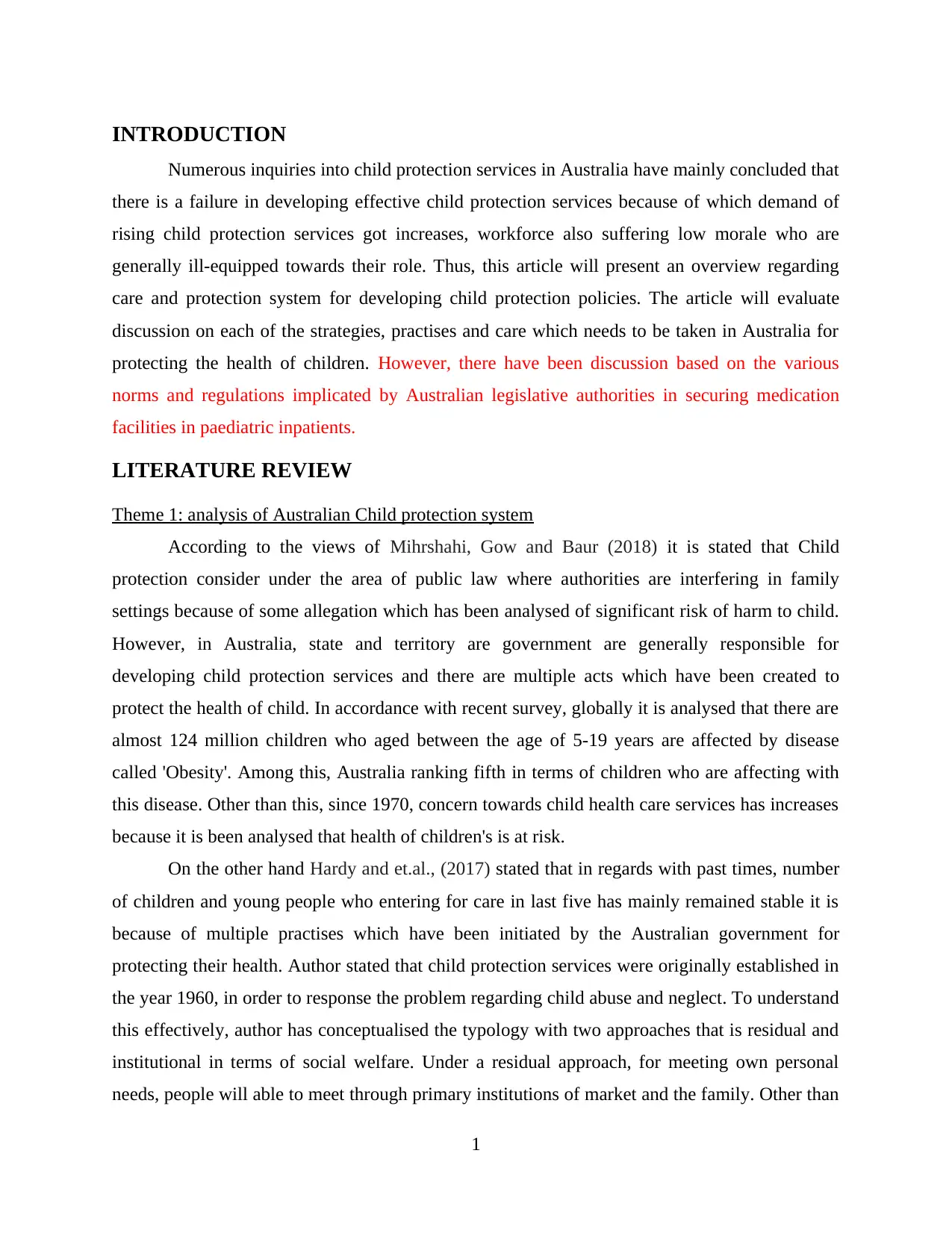
INTRODUCTION
Numerous inquiries into child protection services in Australia have mainly concluded that
there is a failure in developing effective child protection services because of which demand of
rising child protection services got increases, workforce also suffering low morale who are
generally ill-equipped towards their role. Thus, this article will present an overview regarding
care and protection system for developing child protection policies. The article will evaluate
discussion on each of the strategies, practises and care which needs to be taken in Australia for
protecting the health of children. However, there have been discussion based on the various
norms and regulations implicated by Australian legislative authorities in securing medication
facilities in paediatric inpatients.
LITERATURE REVIEW
Theme 1: analysis of Australian Child protection system
According to the views of Mihrshahi, Gow and Baur (2018) it is stated that Child
protection consider under the area of public law where authorities are interfering in family
settings because of some allegation which has been analysed of significant risk of harm to child.
However, in Australia, state and territory are government are generally responsible for
developing child protection services and there are multiple acts which have been created to
protect the health of child. In accordance with recent survey, globally it is analysed that there are
almost 124 million children who aged between the age of 5-19 years are affected by disease
called 'Obesity'. Among this, Australia ranking fifth in terms of children who are affecting with
this disease. Other than this, since 1970, concern towards child health care services has increases
because it is been analysed that health of children's is at risk.
On the other hand Hardy and et.al., (2017) stated that in regards with past times, number
of children and young people who entering for care in last five has mainly remained stable it is
because of multiple practises which have been initiated by the Australian government for
protecting their health. Author stated that child protection services were originally established in
the year 1960, in order to response the problem regarding child abuse and neglect. To understand
this effectively, author has conceptualised the typology with two approaches that is residual and
institutional in terms of social welfare. Under a residual approach, for meeting own personal
needs, people will able to meet through primary institutions of market and the family. Other than
1
Numerous inquiries into child protection services in Australia have mainly concluded that
there is a failure in developing effective child protection services because of which demand of
rising child protection services got increases, workforce also suffering low morale who are
generally ill-equipped towards their role. Thus, this article will present an overview regarding
care and protection system for developing child protection policies. The article will evaluate
discussion on each of the strategies, practises and care which needs to be taken in Australia for
protecting the health of children. However, there have been discussion based on the various
norms and regulations implicated by Australian legislative authorities in securing medication
facilities in paediatric inpatients.
LITERATURE REVIEW
Theme 1: analysis of Australian Child protection system
According to the views of Mihrshahi, Gow and Baur (2018) it is stated that Child
protection consider under the area of public law where authorities are interfering in family
settings because of some allegation which has been analysed of significant risk of harm to child.
However, in Australia, state and territory are government are generally responsible for
developing child protection services and there are multiple acts which have been created to
protect the health of child. In accordance with recent survey, globally it is analysed that there are
almost 124 million children who aged between the age of 5-19 years are affected by disease
called 'Obesity'. Among this, Australia ranking fifth in terms of children who are affecting with
this disease. Other than this, since 1970, concern towards child health care services has increases
because it is been analysed that health of children's is at risk.
On the other hand Hardy and et.al., (2017) stated that in regards with past times, number
of children and young people who entering for care in last five has mainly remained stable it is
because of multiple practises which have been initiated by the Australian government for
protecting their health. Author stated that child protection services were originally established in
the year 1960, in order to response the problem regarding child abuse and neglect. To understand
this effectively, author has conceptualised the typology with two approaches that is residual and
institutional in terms of social welfare. Under a residual approach, for meeting own personal
needs, people will able to meet through primary institutions of market and the family. Other than
1
Paraphrase This Document
Need a fresh take? Get an instant paraphrase of this document with our AI Paraphraser
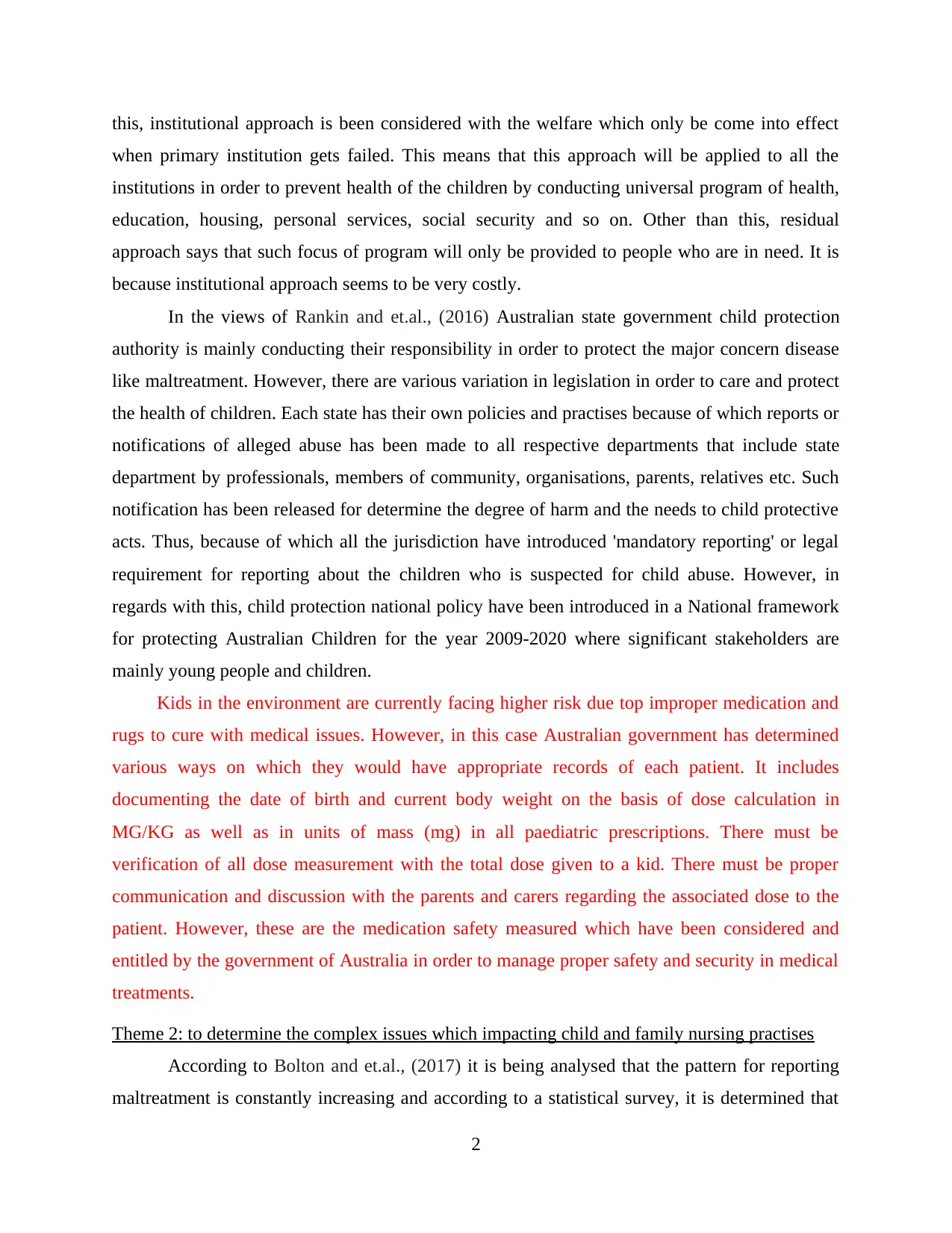
this, institutional approach is been considered with the welfare which only be come into effect
when primary institution gets failed. This means that this approach will be applied to all the
institutions in order to prevent health of the children by conducting universal program of health,
education, housing, personal services, social security and so on. Other than this, residual
approach says that such focus of program will only be provided to people who are in need. It is
because institutional approach seems to be very costly.
In the views of Rankin and et.al., (2016) Australian state government child protection
authority is mainly conducting their responsibility in order to protect the major concern disease
like maltreatment. However, there are various variation in legislation in order to care and protect
the health of children. Each state has their own policies and practises because of which reports or
notifications of alleged abuse has been made to all respective departments that include state
department by professionals, members of community, organisations, parents, relatives etc. Such
notification has been released for determine the degree of harm and the needs to child protective
acts. Thus, because of which all the jurisdiction have introduced 'mandatory reporting' or legal
requirement for reporting about the children who is suspected for child abuse. However, in
regards with this, child protection national policy have been introduced in a National framework
for protecting Australian Children for the year 2009-2020 where significant stakeholders are
mainly young people and children.
Kids in the environment are currently facing higher risk due top improper medication and
rugs to cure with medical issues. However, in this case Australian government has determined
various ways on which they would have appropriate records of each patient. It includes
documenting the date of birth and current body weight on the basis of dose calculation in
MG/KG as well as in units of mass (mg) in all paediatric prescriptions. There must be
verification of all dose measurement with the total dose given to a kid. There must be proper
communication and discussion with the parents and carers regarding the associated dose to the
patient. However, these are the medication safety measured which have been considered and
entitled by the government of Australia in order to manage proper safety and security in medical
treatments.
Theme 2: to determine the complex issues which impacting child and family nursing practises
According to Bolton and et.al., (2017) it is being analysed that the pattern for reporting
maltreatment is constantly increasing and according to a statistical survey, it is determined that
2
when primary institution gets failed. This means that this approach will be applied to all the
institutions in order to prevent health of the children by conducting universal program of health,
education, housing, personal services, social security and so on. Other than this, residual
approach says that such focus of program will only be provided to people who are in need. It is
because institutional approach seems to be very costly.
In the views of Rankin and et.al., (2016) Australian state government child protection
authority is mainly conducting their responsibility in order to protect the major concern disease
like maltreatment. However, there are various variation in legislation in order to care and protect
the health of children. Each state has their own policies and practises because of which reports or
notifications of alleged abuse has been made to all respective departments that include state
department by professionals, members of community, organisations, parents, relatives etc. Such
notification has been released for determine the degree of harm and the needs to child protective
acts. Thus, because of which all the jurisdiction have introduced 'mandatory reporting' or legal
requirement for reporting about the children who is suspected for child abuse. However, in
regards with this, child protection national policy have been introduced in a National framework
for protecting Australian Children for the year 2009-2020 where significant stakeholders are
mainly young people and children.
Kids in the environment are currently facing higher risk due top improper medication and
rugs to cure with medical issues. However, in this case Australian government has determined
various ways on which they would have appropriate records of each patient. It includes
documenting the date of birth and current body weight on the basis of dose calculation in
MG/KG as well as in units of mass (mg) in all paediatric prescriptions. There must be
verification of all dose measurement with the total dose given to a kid. There must be proper
communication and discussion with the parents and carers regarding the associated dose to the
patient. However, these are the medication safety measured which have been considered and
entitled by the government of Australia in order to manage proper safety and security in medical
treatments.
Theme 2: to determine the complex issues which impacting child and family nursing practises
According to Bolton and et.al., (2017) it is being analysed that the pattern for reporting
maltreatment is constantly increasing and according to a statistical survey, it is determined that
2
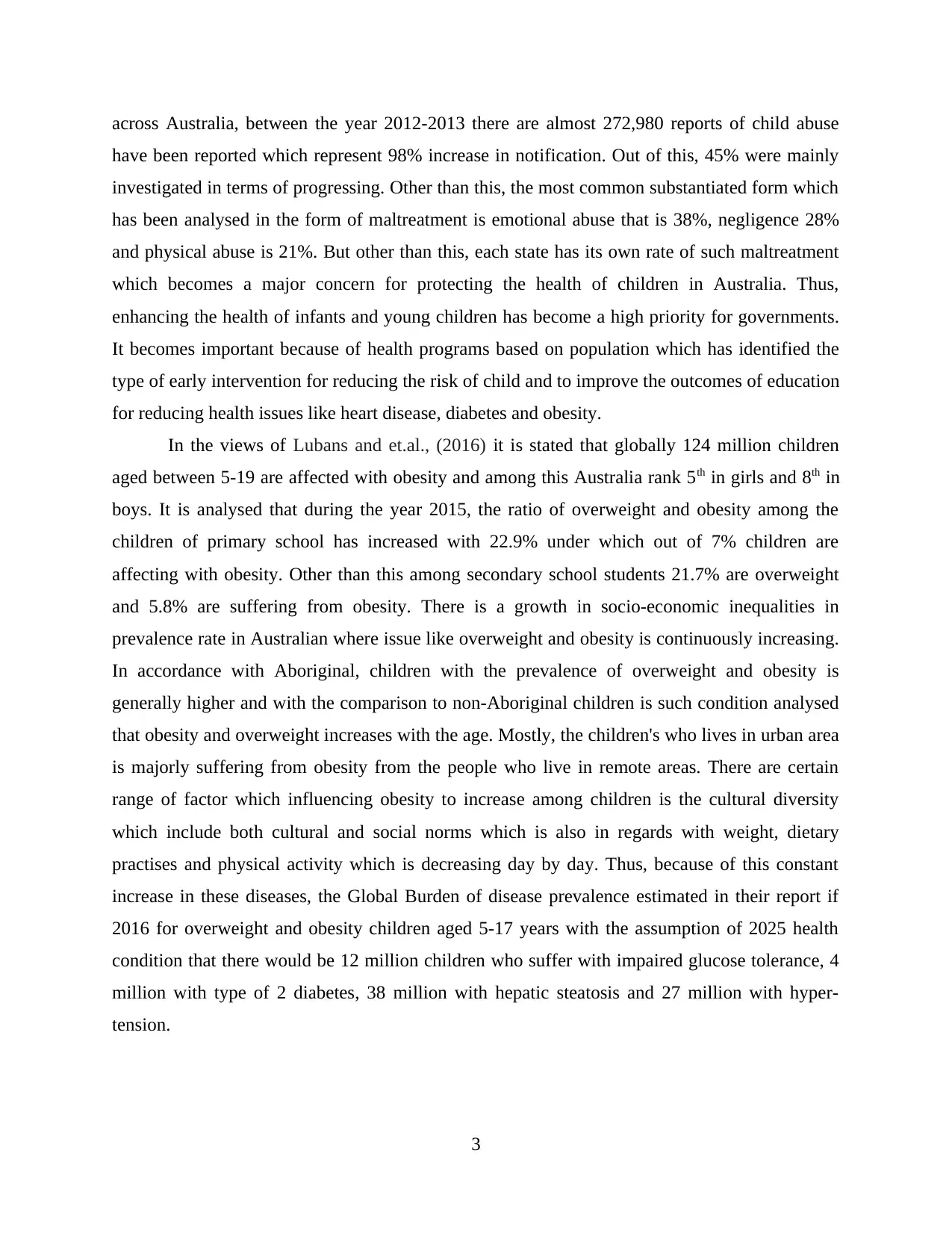
across Australia, between the year 2012-2013 there are almost 272,980 reports of child abuse
have been reported which represent 98% increase in notification. Out of this, 45% were mainly
investigated in terms of progressing. Other than this, the most common substantiated form which
has been analysed in the form of maltreatment is emotional abuse that is 38%, negligence 28%
and physical abuse is 21%. But other than this, each state has its own rate of such maltreatment
which becomes a major concern for protecting the health of children in Australia. Thus,
enhancing the health of infants and young children has become a high priority for governments.
It becomes important because of health programs based on population which has identified the
type of early intervention for reducing the risk of child and to improve the outcomes of education
for reducing health issues like heart disease, diabetes and obesity.
In the views of Lubans and et.al., (2016) it is stated that globally 124 million children
aged between 5-19 are affected with obesity and among this Australia rank 5th in girls and 8th in
boys. It is analysed that during the year 2015, the ratio of overweight and obesity among the
children of primary school has increased with 22.9% under which out of 7% children are
affecting with obesity. Other than this among secondary school students 21.7% are overweight
and 5.8% are suffering from obesity. There is a growth in socio-economic inequalities in
prevalence rate in Australian where issue like overweight and obesity is continuously increasing.
In accordance with Aboriginal, children with the prevalence of overweight and obesity is
generally higher and with the comparison to non-Aboriginal children is such condition analysed
that obesity and overweight increases with the age. Mostly, the children's who lives in urban area
is majorly suffering from obesity from the people who live in remote areas. There are certain
range of factor which influencing obesity to increase among children is the cultural diversity
which include both cultural and social norms which is also in regards with weight, dietary
practises and physical activity which is decreasing day by day. Thus, because of this constant
increase in these diseases, the Global Burden of disease prevalence estimated in their report if
2016 for overweight and obesity children aged 5-17 years with the assumption of 2025 health
condition that there would be 12 million children who suffer with impaired glucose tolerance, 4
million with type of 2 diabetes, 38 million with hepatic steatosis and 27 million with hyper-
tension.
3
have been reported which represent 98% increase in notification. Out of this, 45% were mainly
investigated in terms of progressing. Other than this, the most common substantiated form which
has been analysed in the form of maltreatment is emotional abuse that is 38%, negligence 28%
and physical abuse is 21%. But other than this, each state has its own rate of such maltreatment
which becomes a major concern for protecting the health of children in Australia. Thus,
enhancing the health of infants and young children has become a high priority for governments.
It becomes important because of health programs based on population which has identified the
type of early intervention for reducing the risk of child and to improve the outcomes of education
for reducing health issues like heart disease, diabetes and obesity.
In the views of Lubans and et.al., (2016) it is stated that globally 124 million children
aged between 5-19 are affected with obesity and among this Australia rank 5th in girls and 8th in
boys. It is analysed that during the year 2015, the ratio of overweight and obesity among the
children of primary school has increased with 22.9% under which out of 7% children are
affecting with obesity. Other than this among secondary school students 21.7% are overweight
and 5.8% are suffering from obesity. There is a growth in socio-economic inequalities in
prevalence rate in Australian where issue like overweight and obesity is continuously increasing.
In accordance with Aboriginal, children with the prevalence of overweight and obesity is
generally higher and with the comparison to non-Aboriginal children is such condition analysed
that obesity and overweight increases with the age. Mostly, the children's who lives in urban area
is majorly suffering from obesity from the people who live in remote areas. There are certain
range of factor which influencing obesity to increase among children is the cultural diversity
which include both cultural and social norms which is also in regards with weight, dietary
practises and physical activity which is decreasing day by day. Thus, because of this constant
increase in these diseases, the Global Burden of disease prevalence estimated in their report if
2016 for overweight and obesity children aged 5-17 years with the assumption of 2025 health
condition that there would be 12 million children who suffer with impaired glucose tolerance, 4
million with type of 2 diabetes, 38 million with hepatic steatosis and 27 million with hyper-
tension.
3
⊘ This is a preview!⊘
Do you want full access?
Subscribe today to unlock all pages.

Trusted by 1+ million students worldwide
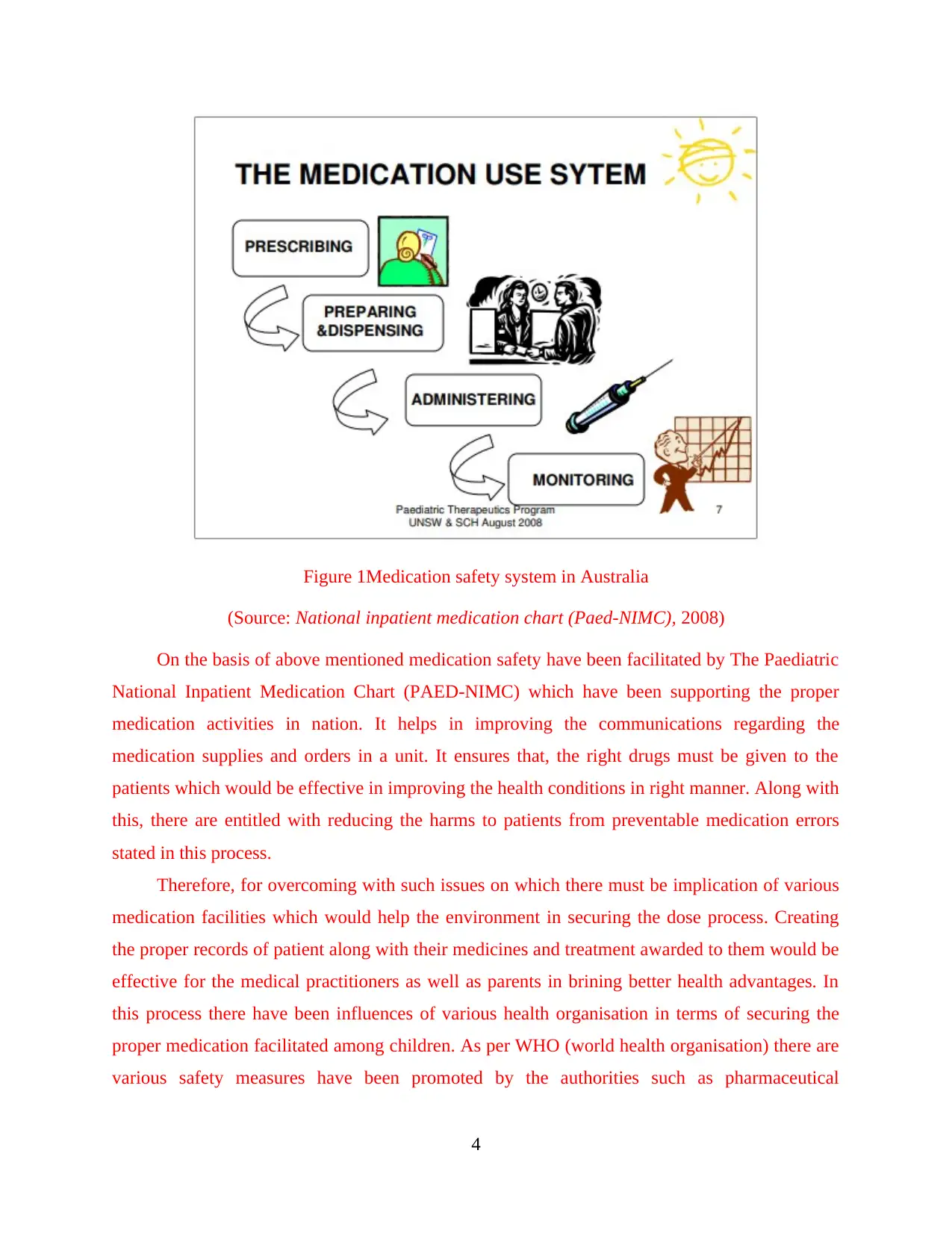
Figure 1Medication safety system in Australia
(Source: National inpatient medication chart (Paed-NIMC), 2008)
On the basis of above mentioned medication safety have been facilitated by The Paediatric
National Inpatient Medication Chart (PAED-NIMC) which have been supporting the proper
medication activities in nation. It helps in improving the communications regarding the
medication supplies and orders in a unit. It ensures that, the right drugs must be given to the
patients which would be effective in improving the health conditions in right manner. Along with
this, there are entitled with reducing the harms to patients from preventable medication errors
stated in this process.
Therefore, for overcoming with such issues on which there must be implication of various
medication facilities which would help the environment in securing the dose process. Creating
the proper records of patient along with their medicines and treatment awarded to them would be
effective for the medical practitioners as well as parents in brining better health advantages. In
this process there have been influences of various health organisation in terms of securing the
proper medication facilitated among children. As per WHO (world health organisation) there are
various safety measures have been promoted by the authorities such as pharmaceutical
4
(Source: National inpatient medication chart (Paed-NIMC), 2008)
On the basis of above mentioned medication safety have been facilitated by The Paediatric
National Inpatient Medication Chart (PAED-NIMC) which have been supporting the proper
medication activities in nation. It helps in improving the communications regarding the
medication supplies and orders in a unit. It ensures that, the right drugs must be given to the
patients which would be effective in improving the health conditions in right manner. Along with
this, there are entitled with reducing the harms to patients from preventable medication errors
stated in this process.
Therefore, for overcoming with such issues on which there must be implication of various
medication facilities which would help the environment in securing the dose process. Creating
the proper records of patient along with their medicines and treatment awarded to them would be
effective for the medical practitioners as well as parents in brining better health advantages. In
this process there have been influences of various health organisation in terms of securing the
proper medication facilitated among children. As per WHO (world health organisation) there are
various safety measures have been promoted by the authorities such as pharmaceutical
4
Paraphrase This Document
Need a fresh take? Get an instant paraphrase of this document with our AI Paraphraser
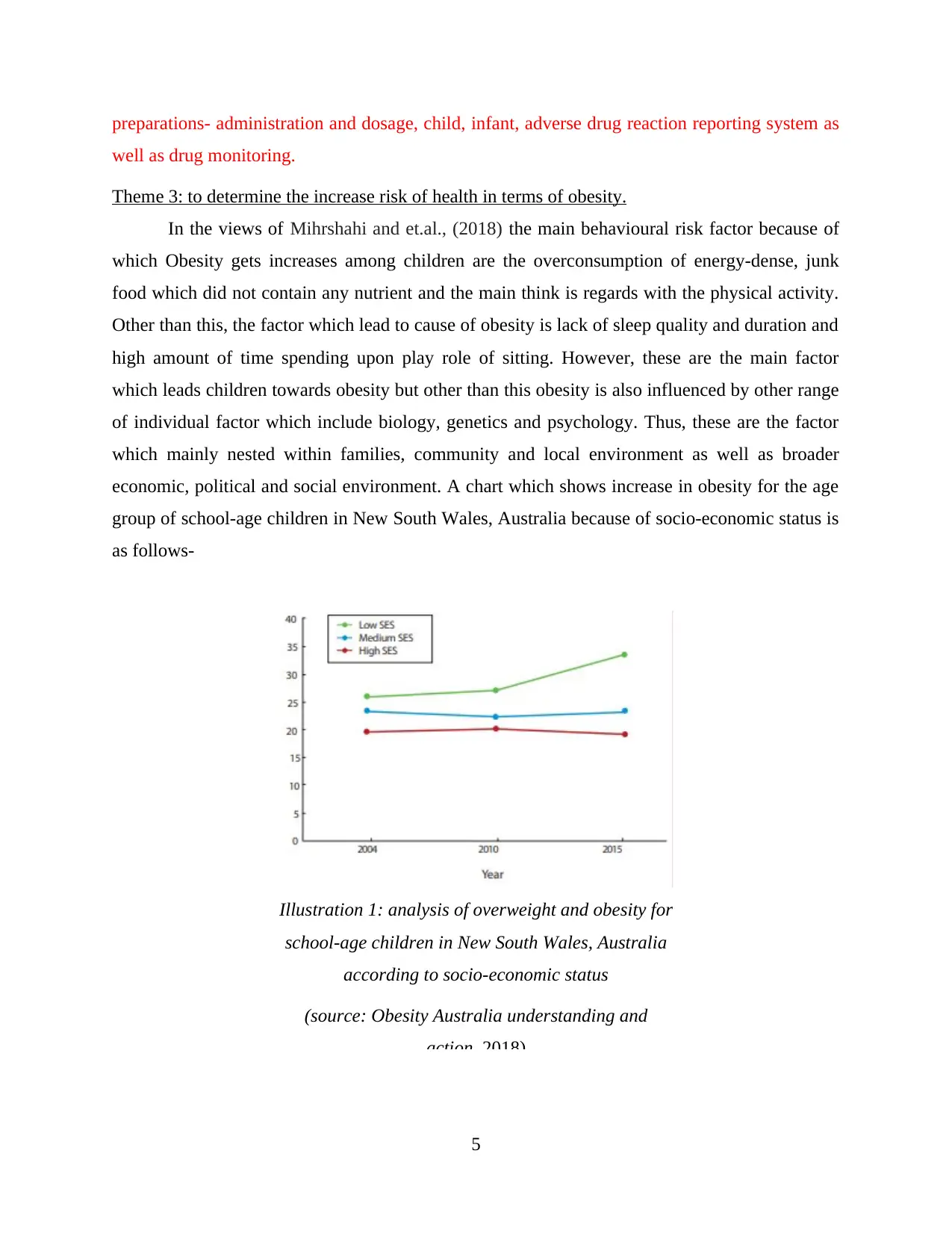
preparations- administration and dosage, child, infant, adverse drug reaction reporting system as
well as drug monitoring.
Theme 3: to determine the increase risk of health in terms of obesity.
In the views of Mihrshahi and et.al., (2018) the main behavioural risk factor because of
which Obesity gets increases among children are the overconsumption of energy-dense, junk
food which did not contain any nutrient and the main think is regards with the physical activity.
Other than this, the factor which lead to cause of obesity is lack of sleep quality and duration and
high amount of time spending upon play role of sitting. However, these are the main factor
which leads children towards obesity but other than this obesity is also influenced by other range
of individual factor which include biology, genetics and psychology. Thus, these are the factor
which mainly nested within families, community and local environment as well as broader
economic, political and social environment. A chart which shows increase in obesity for the age
group of school-age children in New South Wales, Australia because of socio-economic status is
as follows-
5
Illustration 1: analysis of overweight and obesity for
school-age children in New South Wales, Australia
according to socio-economic status
(source: Obesity Australia understanding and
action, 2018)
well as drug monitoring.
Theme 3: to determine the increase risk of health in terms of obesity.
In the views of Mihrshahi and et.al., (2018) the main behavioural risk factor because of
which Obesity gets increases among children are the overconsumption of energy-dense, junk
food which did not contain any nutrient and the main think is regards with the physical activity.
Other than this, the factor which lead to cause of obesity is lack of sleep quality and duration and
high amount of time spending upon play role of sitting. However, these are the main factor
which leads children towards obesity but other than this obesity is also influenced by other range
of individual factor which include biology, genetics and psychology. Thus, these are the factor
which mainly nested within families, community and local environment as well as broader
economic, political and social environment. A chart which shows increase in obesity for the age
group of school-age children in New South Wales, Australia because of socio-economic status is
as follows-
5
Illustration 1: analysis of overweight and obesity for
school-age children in New South Wales, Australia
according to socio-economic status
(source: Obesity Australia understanding and
action, 2018)

Among all the factors which influence for childhood obesity prevention include weight
status of parents, food preferences preferred by family and the availability of food in home,
family preferences for and modelling of active recreation, family rules and preference for screen
based entertainment, knowledge, education, skills, activity pattern and lastly socio-economic
factor. These are the main factor which leads to increase obesity among the age group of 5-19
year old children. Author also stated that other than factors like government policies, industry
and retail sector, transport, agriculture, media, social norms and values and health care practises.
These all are comes under the societal and political influences which mainly influence childhood
obesity prevention. Individual factor which influence such prevention include demographic
factors under which gender and ethnicity terms will get included.
Other than this Hayes and et.al., (2019) stated that the prevalence of obesity in Australian
children in generally lower than the adults it is because of statistics which shown alarming where
it has been analysed that ratio of overweight and obesity in comparison to year 1985-1995 has
becomes doubled by the year 2008 where it has been increased with 25% and it is estimated that
with the year 2025, one-third of the Australian population will be overweight and obese. This,
statistics determine that the children who become obese will likely to stay obese in their
adulthood as well because of which they have to face many chronic diseases like diabetes,
cardiovascular disease, certain cancer and other complication which lead toward risk in their
lives. The factor because of which obesity among children's are increases is the choice of food
where nowadays, children's mostly get attracted towards eating of food which has high fart and
sugar which are considered as main ingredients of generating obesity among them. Other than
this, children's nowadays did not involve in doing any kind of physical activity which is only
because of huge technological advancement which has freeze physical activity of children.
However, according to a statistics it is measured that Australian children watch on an average 2.5
hours of television per day and with that they also spend huge time of computers and video game
which has replaced them with active ones to inactive ones.
Theme 4: recommendation for prevention of obesity in children and adolescents
According to Partridge and Redfern (2018) obesity risk can be passed from one
generation to next and maternal obesity may have adverse influence on fetal development and
weight status. Thus, it is recommended that by achieving healthy weight before pregnancy and a
healthy weight gain during pregnancy was the first and foremost contribution for preventing
6
status of parents, food preferences preferred by family and the availability of food in home,
family preferences for and modelling of active recreation, family rules and preference for screen
based entertainment, knowledge, education, skills, activity pattern and lastly socio-economic
factor. These are the main factor which leads to increase obesity among the age group of 5-19
year old children. Author also stated that other than factors like government policies, industry
and retail sector, transport, agriculture, media, social norms and values and health care practises.
These all are comes under the societal and political influences which mainly influence childhood
obesity prevention. Individual factor which influence such prevention include demographic
factors under which gender and ethnicity terms will get included.
Other than this Hayes and et.al., (2019) stated that the prevalence of obesity in Australian
children in generally lower than the adults it is because of statistics which shown alarming where
it has been analysed that ratio of overweight and obesity in comparison to year 1985-1995 has
becomes doubled by the year 2008 where it has been increased with 25% and it is estimated that
with the year 2025, one-third of the Australian population will be overweight and obese. This,
statistics determine that the children who become obese will likely to stay obese in their
adulthood as well because of which they have to face many chronic diseases like diabetes,
cardiovascular disease, certain cancer and other complication which lead toward risk in their
lives. The factor because of which obesity among children's are increases is the choice of food
where nowadays, children's mostly get attracted towards eating of food which has high fart and
sugar which are considered as main ingredients of generating obesity among them. Other than
this, children's nowadays did not involve in doing any kind of physical activity which is only
because of huge technological advancement which has freeze physical activity of children.
However, according to a statistics it is measured that Australian children watch on an average 2.5
hours of television per day and with that they also spend huge time of computers and video game
which has replaced them with active ones to inactive ones.
Theme 4: recommendation for prevention of obesity in children and adolescents
According to Partridge and Redfern (2018) obesity risk can be passed from one
generation to next and maternal obesity may have adverse influence on fetal development and
weight status. Thus, it is recommended that by achieving healthy weight before pregnancy and a
healthy weight gain during pregnancy was the first and foremost contribution for preventing
6
⊘ This is a preview!⊘
Do you want full access?
Subscribe today to unlock all pages.

Trusted by 1+ million students worldwide
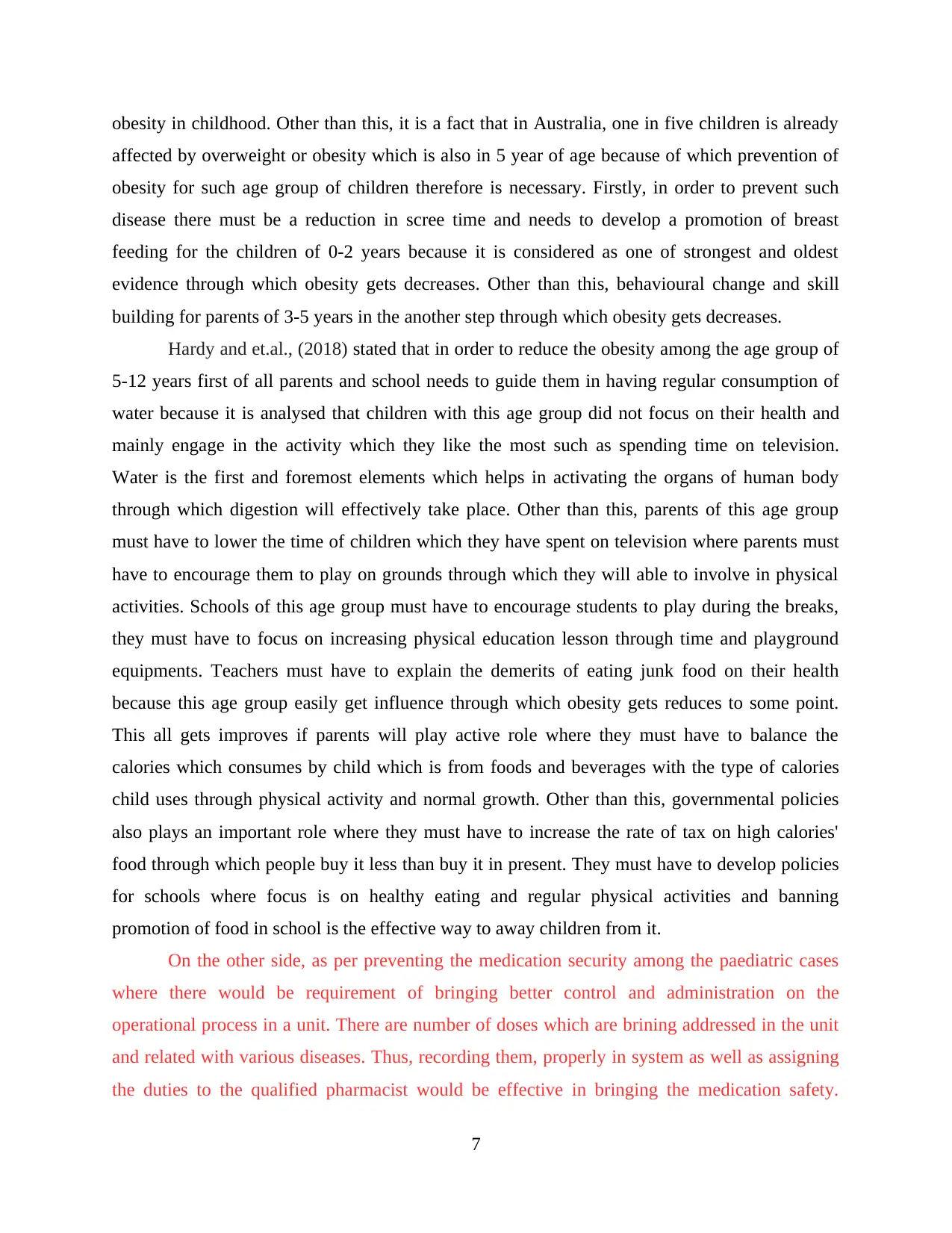
obesity in childhood. Other than this, it is a fact that in Australia, one in five children is already
affected by overweight or obesity which is also in 5 year of age because of which prevention of
obesity for such age group of children therefore is necessary. Firstly, in order to prevent such
disease there must be a reduction in scree time and needs to develop a promotion of breast
feeding for the children of 0-2 years because it is considered as one of strongest and oldest
evidence through which obesity gets decreases. Other than this, behavioural change and skill
building for parents of 3-5 years in the another step through which obesity gets decreases.
Hardy and et.al., (2018) stated that in order to reduce the obesity among the age group of
5-12 years first of all parents and school needs to guide them in having regular consumption of
water because it is analysed that children with this age group did not focus on their health and
mainly engage in the activity which they like the most such as spending time on television.
Water is the first and foremost elements which helps in activating the organs of human body
through which digestion will effectively take place. Other than this, parents of this age group
must have to lower the time of children which they have spent on television where parents must
have to encourage them to play on grounds through which they will able to involve in physical
activities. Schools of this age group must have to encourage students to play during the breaks,
they must have to focus on increasing physical education lesson through time and playground
equipments. Teachers must have to explain the demerits of eating junk food on their health
because this age group easily get influence through which obesity gets reduces to some point.
This all gets improves if parents will play active role where they must have to balance the
calories which consumes by child which is from foods and beverages with the type of calories
child uses through physical activity and normal growth. Other than this, governmental policies
also plays an important role where they must have to increase the rate of tax on high calories'
food through which people buy it less than buy it in present. They must have to develop policies
for schools where focus is on healthy eating and regular physical activities and banning
promotion of food in school is the effective way to away children from it.
On the other side, as per preventing the medication security among the paediatric cases
where there would be requirement of bringing better control and administration on the
operational process in a unit. There are number of doses which are brining addressed in the unit
and related with various diseases. Thus, recording them, properly in system as well as assigning
the duties to the qualified pharmacist would be effective in bringing the medication safety.
7
affected by overweight or obesity which is also in 5 year of age because of which prevention of
obesity for such age group of children therefore is necessary. Firstly, in order to prevent such
disease there must be a reduction in scree time and needs to develop a promotion of breast
feeding for the children of 0-2 years because it is considered as one of strongest and oldest
evidence through which obesity gets decreases. Other than this, behavioural change and skill
building for parents of 3-5 years in the another step through which obesity gets decreases.
Hardy and et.al., (2018) stated that in order to reduce the obesity among the age group of
5-12 years first of all parents and school needs to guide them in having regular consumption of
water because it is analysed that children with this age group did not focus on their health and
mainly engage in the activity which they like the most such as spending time on television.
Water is the first and foremost elements which helps in activating the organs of human body
through which digestion will effectively take place. Other than this, parents of this age group
must have to lower the time of children which they have spent on television where parents must
have to encourage them to play on grounds through which they will able to involve in physical
activities. Schools of this age group must have to encourage students to play during the breaks,
they must have to focus on increasing physical education lesson through time and playground
equipments. Teachers must have to explain the demerits of eating junk food on their health
because this age group easily get influence through which obesity gets reduces to some point.
This all gets improves if parents will play active role where they must have to balance the
calories which consumes by child which is from foods and beverages with the type of calories
child uses through physical activity and normal growth. Other than this, governmental policies
also plays an important role where they must have to increase the rate of tax on high calories'
food through which people buy it less than buy it in present. They must have to develop policies
for schools where focus is on healthy eating and regular physical activities and banning
promotion of food in school is the effective way to away children from it.
On the other side, as per preventing the medication security among the paediatric cases
where there would be requirement of bringing better control and administration on the
operational process in a unit. There are number of doses which are brining addressed in the unit
and related with various diseases. Thus, recording them, properly in system as well as assigning
the duties to the qualified pharmacist would be effective in bringing the medication safety.
7
Paraphrase This Document
Need a fresh take? Get an instant paraphrase of this document with our AI Paraphraser
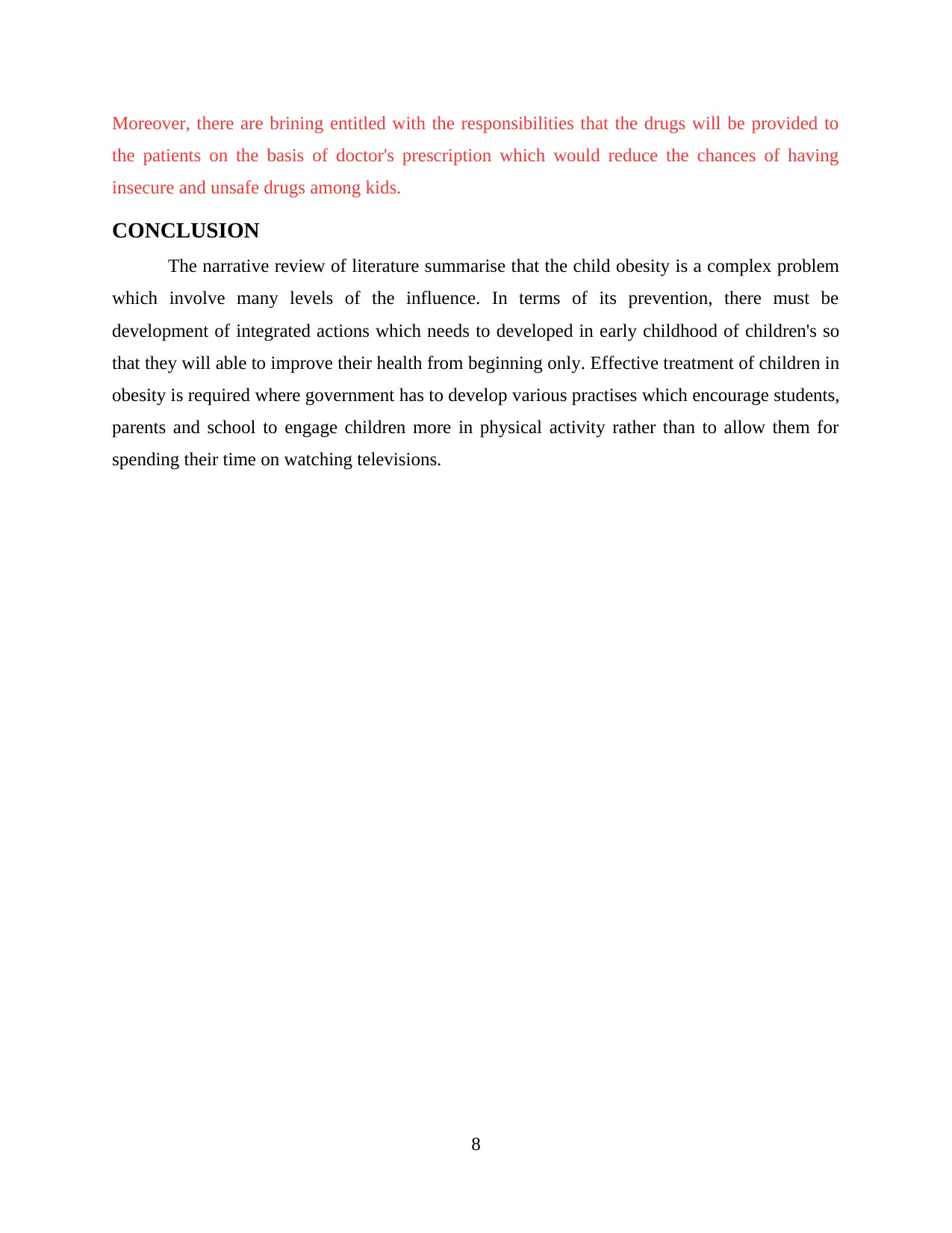
Moreover, there are brining entitled with the responsibilities that the drugs will be provided to
the patients on the basis of doctor's prescription which would reduce the chances of having
insecure and unsafe drugs among kids.
CONCLUSION
The narrative review of literature summarise that the child obesity is a complex problem
which involve many levels of the influence. In terms of its prevention, there must be
development of integrated actions which needs to developed in early childhood of children's so
that they will able to improve their health from beginning only. Effective treatment of children in
obesity is required where government has to develop various practises which encourage students,
parents and school to engage children more in physical activity rather than to allow them for
spending their time on watching televisions.
8
the patients on the basis of doctor's prescription which would reduce the chances of having
insecure and unsafe drugs among kids.
CONCLUSION
The narrative review of literature summarise that the child obesity is a complex problem
which involve many levels of the influence. In terms of its prevention, there must be
development of integrated actions which needs to developed in early childhood of children's so
that they will able to improve their health from beginning only. Effective treatment of children in
obesity is required where government has to develop various practises which encourage students,
parents and school to engage children more in physical activity rather than to allow them for
spending their time on watching televisions.
8
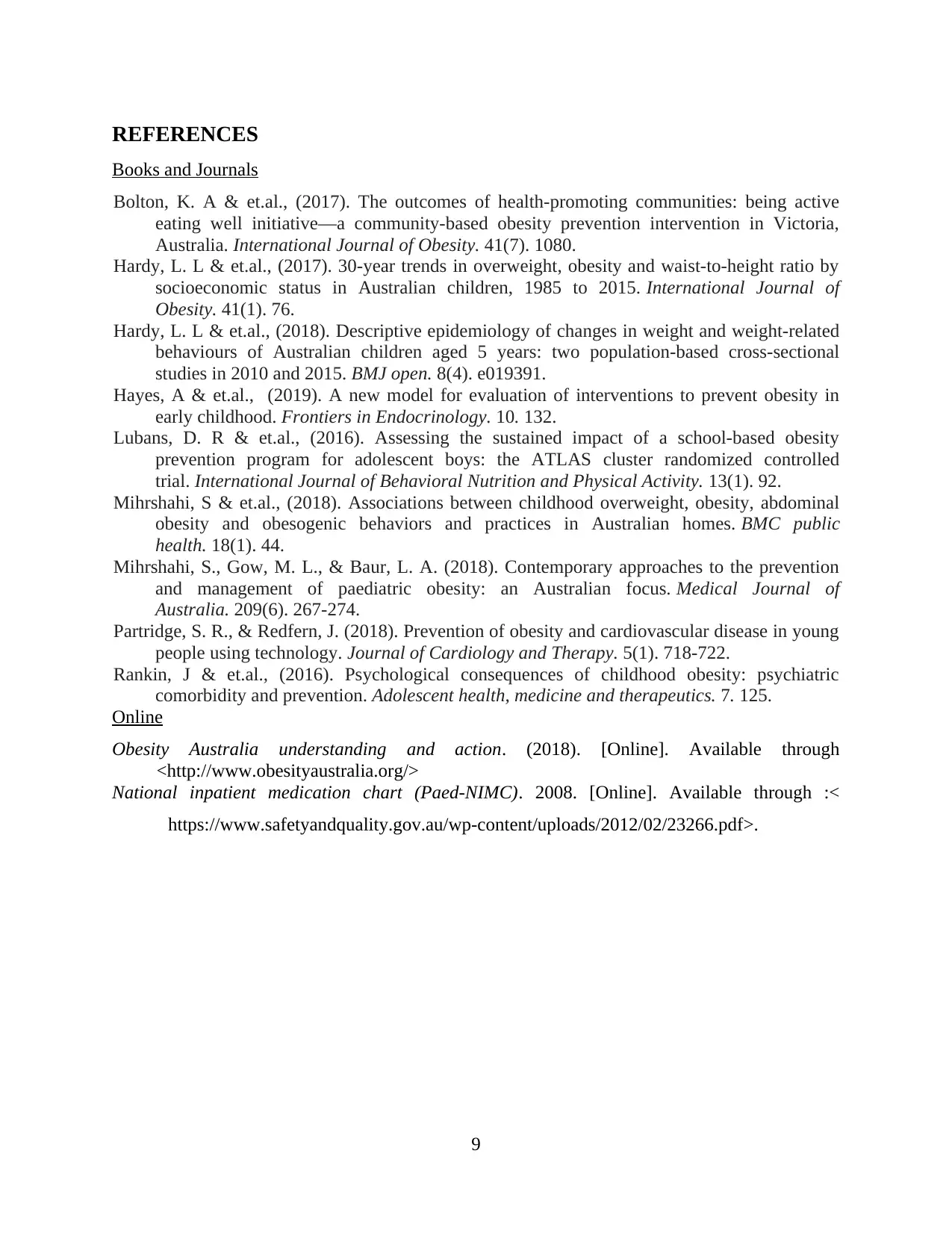
REFERENCES
Books and Journals
Bolton, K. A & et.al., (2017). The outcomes of health-promoting communities: being active
eating well initiative—a community-based obesity prevention intervention in Victoria,
Australia. International Journal of Obesity. 41(7). 1080.
Hardy, L. L & et.al., (2017). 30-year trends in overweight, obesity and waist-to-height ratio by
socioeconomic status in Australian children, 1985 to 2015. International Journal of
Obesity. 41(1). 76.
Hardy, L. L & et.al., (2018). Descriptive epidemiology of changes in weight and weight-related
behaviours of Australian children aged 5 years: two population-based cross-sectional
studies in 2010 and 2015. BMJ open. 8(4). e019391.
Hayes, A & et.al., (2019). A new model for evaluation of interventions to prevent obesity in
early childhood. Frontiers in Endocrinology. 10. 132.
Lubans, D. R & et.al., (2016). Assessing the sustained impact of a school-based obesity
prevention program for adolescent boys: the ATLAS cluster randomized controlled
trial. International Journal of Behavioral Nutrition and Physical Activity. 13(1). 92.
Mihrshahi, S & et.al., (2018). Associations between childhood overweight, obesity, abdominal
obesity and obesogenic behaviors and practices in Australian homes. BMC public
health. 18(1). 44.
Mihrshahi, S., Gow, M. L., & Baur, L. A. (2018). Contemporary approaches to the prevention
and management of paediatric obesity: an Australian focus. Medical Journal of
Australia. 209(6). 267-274.
Partridge, S. R., & Redfern, J. (2018). Prevention of obesity and cardiovascular disease in young
people using technology. Journal of Cardiology and Therapy. 5(1). 718-722.
Rankin, J & et.al., (2016). Psychological consequences of childhood obesity: psychiatric
comorbidity and prevention. Adolescent health, medicine and therapeutics. 7. 125.
Online
Obesity Australia understanding and action. (2018). [Online]. Available through
<http://www.obesityaustralia.org/>
National inpatient medication chart (Paed-NIMC). 2008. [Online]. Available through :<
https://www.safetyandquality.gov.au/wp-content/uploads/2012/02/23266.pdf>.
9
Books and Journals
Bolton, K. A & et.al., (2017). The outcomes of health-promoting communities: being active
eating well initiative—a community-based obesity prevention intervention in Victoria,
Australia. International Journal of Obesity. 41(7). 1080.
Hardy, L. L & et.al., (2017). 30-year trends in overweight, obesity and waist-to-height ratio by
socioeconomic status in Australian children, 1985 to 2015. International Journal of
Obesity. 41(1). 76.
Hardy, L. L & et.al., (2018). Descriptive epidemiology of changes in weight and weight-related
behaviours of Australian children aged 5 years: two population-based cross-sectional
studies in 2010 and 2015. BMJ open. 8(4). e019391.
Hayes, A & et.al., (2019). A new model for evaluation of interventions to prevent obesity in
early childhood. Frontiers in Endocrinology. 10. 132.
Lubans, D. R & et.al., (2016). Assessing the sustained impact of a school-based obesity
prevention program for adolescent boys: the ATLAS cluster randomized controlled
trial. International Journal of Behavioral Nutrition and Physical Activity. 13(1). 92.
Mihrshahi, S & et.al., (2018). Associations between childhood overweight, obesity, abdominal
obesity and obesogenic behaviors and practices in Australian homes. BMC public
health. 18(1). 44.
Mihrshahi, S., Gow, M. L., & Baur, L. A. (2018). Contemporary approaches to the prevention
and management of paediatric obesity: an Australian focus. Medical Journal of
Australia. 209(6). 267-274.
Partridge, S. R., & Redfern, J. (2018). Prevention of obesity and cardiovascular disease in young
people using technology. Journal of Cardiology and Therapy. 5(1). 718-722.
Rankin, J & et.al., (2016). Psychological consequences of childhood obesity: psychiatric
comorbidity and prevention. Adolescent health, medicine and therapeutics. 7. 125.
Online
Obesity Australia understanding and action. (2018). [Online]. Available through
<http://www.obesityaustralia.org/>
National inpatient medication chart (Paed-NIMC). 2008. [Online]. Available through :<
https://www.safetyandquality.gov.au/wp-content/uploads/2012/02/23266.pdf>.
9
⊘ This is a preview!⊘
Do you want full access?
Subscribe today to unlock all pages.

Trusted by 1+ million students worldwide
1 out of 12
Related Documents
Your All-in-One AI-Powered Toolkit for Academic Success.
+13062052269
info@desklib.com
Available 24*7 on WhatsApp / Email
![[object Object]](/_next/static/media/star-bottom.7253800d.svg)
Unlock your academic potential
Copyright © 2020–2025 A2Z Services. All Rights Reserved. Developed and managed by ZUCOL.





